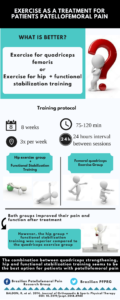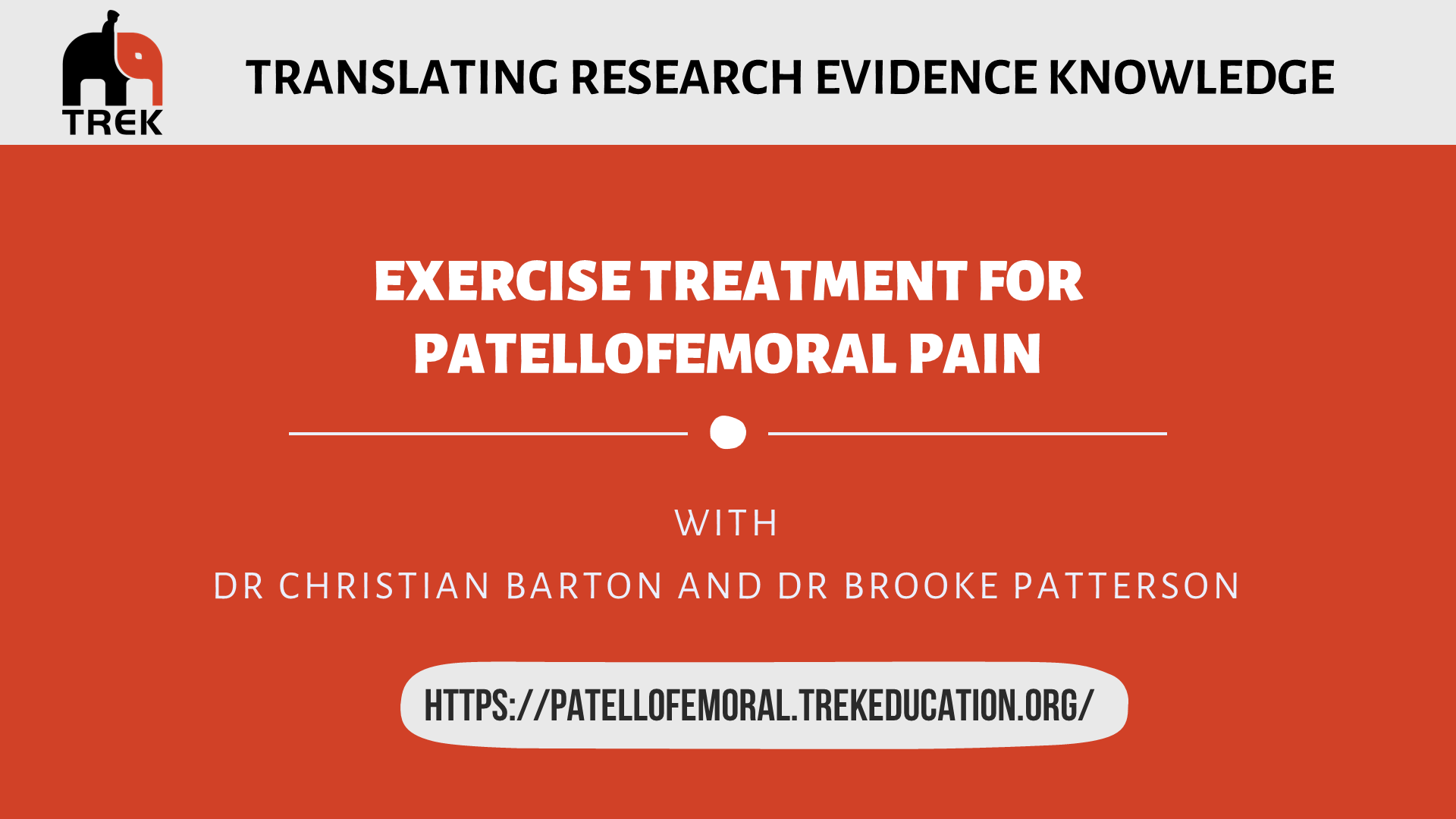Based on current evidence and clinical practice, exercise therapy forms the cornerstone of management for patellofemoral pain.
In this section, you will find information about which muscles patients with patellofemoral pain should exercise to improve the chances of completely recovery.
The most recent consensus statement from expert panel composed by researchers and therapists made two recommendations regarding exercise therapy.
1. Exercise is recommended to reduce pain in the short, medium and long term, and improve function in the medium and long term.
2. Combining hip and knee exercises is recommended to reduce pain and improve function in the short, medium and long term, and this combination should be used in preference to knee exercises alone.
In the early stages of exercise rehabilitation, the current evidence indicates that hip focused exercises may be more effective than knee focused exercises. However, in the longer term, combining hip and knee exercises is likely to improve patient’s outcomes.
 Patients with patellofemoral pain generally have weak and poorly functioning hip muscles. It is thought that this weakness and poor function may not be the reason as to why patients develop pain in the first place. Instead, hip muscles may become weak because patients have changed the way they move, or move less to avoid pain.
Patients with patellofemoral pain generally have weak and poorly functioning hip muscles. It is thought that this weakness and poor function may not be the reason as to why patients develop pain in the first place. Instead, hip muscles may become weak because patients have changed the way they move, or move less to avoid pain.
Weak and poorly functioning hip muscles are thought to put more stress onto patella during activities like running, walking on stairs and squatting. This is because the muscles can no longer control the femur well enough, allowing it to roll under the patella.
A number of good research trials report that hip targeted exercises are effective in reducing patellofemoral pain. In the longer term, combining both quadriceps and hip muscle targeted exercise is the most effective approach to reduce pain.
Blood flow restriction training involves exercise whilst using a pneumatic cuff to restrict blood flow, similar to a blood pressure cuff. The decreased oxygen to the muscle, in combination with reduced ability to get rid of waste products from the exercise (e.g. lactic acid), causes the muscle to work a lot harder than without occlusion.
The muscle is forced to adapt to the strenuous conditions, by increasing in size and strength, irrespective of the lighter weight being used. The advantage of this approach is that to improve muscle strength you don’t have to use heavy weights, which can often aggravate injuries due to the high load through the joint.
Blood flow restriction may in theory be very beneficial in people with musculoskeletal pain who need to get stronger to improve the management of their condition but pain stops completing an adequate gym program.
For patients with patellofemoral pain exercises with blood flow restriction seems to be positive, see a summary of an article and a short video below.
Findings:
-
Blood flow restriction (BFR) training at 30% 1RM reduced pain with daily activity more than standardised quadriceps strengthening (70% 1RM) over 8 weeks in patients with patellofemoral pain. There was no significant difference in worst pain or Anterior Knee Pain Scale.
-
Patients with patellofemoral pain who have pain with resisted knee extension achieve greater improvement in quadriceps strength by performing exercises with BFR than standardised quadriceps strengthening.
Clinical implications:
-
Both standardised quadriceps strengthening and BFR can be used to reduce pain from patients with patellofemoral pain and increase quadriceps strength.
-
BFR may be a useful alternative for patients with patellofemoral pain who are not tolerating the load of standardised quadriceps strengthening programmes due to pain.
Listen to world-renowned physiotherapist and expert in managing patellofemoral pain, Professor Kay Crossley (La Trobe Sport and Exercise Medicine Research Centre) discuss surgery, exercise, and other treatments for patellofemoral pain:
References
- Barton 2013. Gluteal muscle activity and patellofemoral pain syndrome: a systematic review.
- Crossley 2016. Patellofemoral pain consensus statement from the 4th International Patellofemoral PainResearch Retreat, Manchester. Part 2: recommended physical interventions (exercise, taping, bracing, foot orthoses and combined interventions).
- 2017. Quadriceps strengthening with and without blood flow restriction in the treatment of patellofemoral pain: a double-blind randomised trial.
- Lack 2015. Proximal muscle rehabilitation is effective for patellofemoral pain: a systematic review with meta-analysis.


